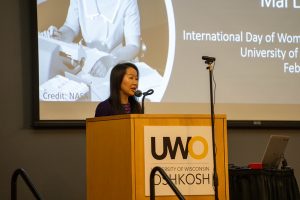Need for more women, girls in STEM
February 23, 2022
A doctoral candidate in electrical and computer engineering highlighted her work in the STEM field and the opportunities it has given her despite adversity, as part of the International Day of Women and Girls in Science.
“You can see adversity as a bridge to something greater or you can choose to see it as a weight that weighs you down,” Mai Lee Chang said at the UW Oshkosh presentation on Feb. 11. “We have that choice.”
Since 2015, the United Nations has recognized Feb. 11 as the International Day of Women and Girls in Science. This highlights the work that has been done and the work that remains to remove the many barriers women and girls face in STEM.
“It’s important for us to remember [women in STEM and] their stories and realize how far we’ve come,” Chang said. “A part of that is realizing how much we still need to go because the STEM field is still heavily dominated by men.”
Chang was born in Ban Vinai Refugee Camp, Thailand. Her family later immigrated to the U.S. as refugees of the Vietnam War to California.

Mai Lee Chang speaking to UWO students for International Women and Girls in Science Day. Chang is a Ph.D. candidate in electrical and computer engineering at the University of Texas Austin.
“I look [at photos of my family] from time to time because it reminds me about the resilience of the generations before me, and just how much they had to persevere for my siblings and me to have experiences like this,” Chang said.
It was hard for Chang as a child because of the language barrier. She did not know English besides the word ‘restroom.’ Besides the language barrier, she faced culture clashes.
After moving around throughout her life, she ended up graduating from Oshkosh North High School.
She received a bachelor’s degree in engineering mechanics and astronautics in 2010 and a master’s in industrial and systems engineering in 2012, both from UW-Madison.
“My perspective [while choosing a major freshman year] was that UW-Madison, that campus, is not bounded by UW-Madison,” Chang said. “My campus is the world. I took opportunities to study abroad to learn more about the international component.”
Prior to joining the University of Texas at Austin as a Ph.D. candidate, she worked as an engineer at the NASA Johnson Space Center. She was the first Hmong person to be employed at NASA.
She took part in the NASA Pathways internships while at UW-Madison and got a job there soon afterwards. At NASA, she worked on human-robot interaction and human-automation interaction research. She assisted the Orion Spacecraft, whose goal was to “carry man to Mars and beyond,” by helping software “meet human systems requirements.”
She also worked with Engineers without Borders by helping build a water storage tank for a village for 200 people in Thailand.
“The most rewarding part is to see the positive impacts,” Chang said. “The goal is to empower the villagers … to give them hope that tomorrow will be better.”
In her current work toward a Ph.D., Chang’s topic is human-robot teamwork.
She is advised by Dr. Andrea Thomaz in the Socially Intelligent Machines Lab where she creates algorithms that enable robotic teammates to reason about task performance and fairness to achieve long-lasting human-robot partnerships.
The robots from their lab have been featured in the MIT Tech Review and recently in National Geographic.
Chang said a robot is made of a computer, which is essentially its brain. It also needs sensors like microphones and cameras, in a sense representing eyes and ears and actuators such as arms and wheels so it can move around.
“For you and I, when we see a situation, it’s really easy for us to adapt and to be helpful right away,” Chang said. “For a robot, this is a challenging environment [to be in] and to understand what’s going on.”
Chang said for a successful human-robot interaction, it is necessary to have perception, planning, communication, and to learn from people and real-time experiences.
This led to her asking the question: “How do we design valuable robotic teammates?”
“If you reflect on the teamwork you’ve been a part of and the types of teammates you’ve had, I’m sure you can think of all these multiple factors,” Chang said. “Robotic teammates must be able to reason about multiple dimensions of teamwork. Research shows people treat robots as other people too.”
In the lab, Chang and others try to simplify interactions with robots. Various tasks and trials are done between the robots and participants to help the robot prioritize efficiency or effort in what they do.
“There are plenty of other people who may need help [from robots],” Chang said during her presentation. “For me, what’s exciting is the potential for robots to be able to help us in various ways in our daily lives.”
Chang predicts more robots will enter the food industry, healthcare and maintenance soon.
“Your starting point doesn’t automatically determine your destination,” Chang said. “As a child I didn’t envision being an engineer, working for NASA, being a roboticist or pursuing my Ph.D. I’m really excited to see the amazing things that you’re going to be doing and that we really need each of you.”
The UWO Women’s Center is working on creating a version of the full video of her talk with spoken Hmong language interpretation they will post on their YouTube page when complete.













